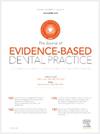低浓度二甲亚砜引物治疗宫颈非恶性病变三年临床评价:一项随机对照试验
IF 4
4区 医学
Q1 DENTISTRY, ORAL SURGERY & MEDICINE
引用次数: 0
摘要
目的观察1%二甲基亚砜(DMSO/H2O)牙本质预处理对两步蚀刻-冲洗粘接剂临床性能的影响,并进行36个月的随访。方法选择29例82例非宫颈糜烂性ncls患者作为研究对象。nccl随机分为2组。在橡胶坝隔离的条件下,对两组进行酸蚀,然后用(Single-bond2, 3M-ESPE)键合,再用纳米杂化复合材料(Z350XT, 3M-ESPE)修复。仅干预组用1% DMSO/H2O浸泡60s,刻蚀后和粘接前吸干。在基线、12个月、24个月和36个月使用FDI标准对修复进行评估。组间比较采用卡方检验(P ≤ .05),组内比较采用Cochran’s q检验(P ≤ .0083)。结果在本研究中,两组在基线和12、24、36个月时的组间比较,除36个月时的边缘变色有统计学差异(P <; .05)外,所有测试结果均无统计学差异(P >; .05),DSMO有统计学差异(P <; .05)。对照组组内比较显示,所有测试参数随时间的变化有统计学意义(P <; .001),DSMO组内随时间的变化也有统计学意义(P <; .0083)。结论两步蚀刻-冲洗胶粘剂联合1% DMSO预处理的临床效果优于未预处理的对照组。更长的随访时间和更高浓度的DMSO预处理应在未来进行评估。多项实验室研究表明,DMSO预处理可以改善杂交层的质量和完整性。然而,经过36个月的随访,该临床试验证明了该方案的临床有效性。本文章由计算机程序翻译,如有差异,请以英文原文为准。
THREE YEARS CLINICAL ASSESSMENT OF LOW CONCENTRATION DIMETHYL SULFOXIDE PRIMER IN NON CARIOUS CERVICAL LESIONS: A RANDOMIZED CONTROLLED TRIAL
Objectives
to evaluate the clinical effectiveness of 1% dimethyl-sulfoxide (DMSO/H2O) dentin pretreatment on the clinical performance of 2-step etch-rinse adhesive after 36-months of a follow-up.
Methods
Twenty-nine patients with 82 non carious-cervical lesions NCCLs were eligible for the study. NCCLs were randomly distributed into 2 equal groups. Both groups were acid etched then bonded with (Single-bond2, 3M-ESPE) and restored with a nanohybrid composite (Z350XT, 3M-ESPE) under rubber-dam isolation. Only for the intervention group 1% DMSO/H2O was applied for 60s then blot dried after etching and before bonding. The restorations were evaluated at baseline, 12-, 24-, and 36-months using FDI criteria for evaluation of the restoration. For the statistical analysis, intergroup comparison between interventions was performed using Chi-Square-test (P ≤ .05), intragroup comparison within each intervention was performed using the Cochran's Q-test (P ≤ .0083).
Results
In the current study, intergroup comparison between both groups at baseline and after 12, 24 and 36 months showed no statistically significant differences for all tested outcomes (P > .05), except for marginal discoloration at 36 months, where there was statistically significant difference (P < .05) favoring DSMO. Intragroup comparison within control revealed statistically significant deterioration through time (P < .001) for all tested parameters, also within DSMO there was statistically significant change through time (P < .0083).
Conclusion
The clinical performance of a 2-step etch-rinse adhesive in combination with 1% DMSO pretreatment was better than the control without pretreatment. Longer follow-up and higher concentrations of DMSO pretreatment should be evaluated in the future.
Clinical Significance
Several laboratory studies showed that DMSO pretreatment improves the hybrid layer quality and integrity. However, this clinical trial gave the proof of the clinical effectiveness of this protocol after 36-months follow-up.
求助全文
通过发布文献求助,成功后即可免费获取论文全文。
去求助
来源期刊

Journal of Evidence-Based Dental Practice
DENTISTRY, ORAL SURGERY & MEDICINE-
CiteScore
6.00
自引率
16.70%
发文量
105
审稿时长
28 days
期刊介绍:
The Journal of Evidence-Based Dental Practice presents timely original articles, as well as reviews of articles on the results and outcomes of clinical procedures and treatment. The Journal advocates the use or rejection of a procedure based on solid, clinical evidence found in literature. The Journal''s dynamic operating principles are explicitness in process and objectives, publication of the highest-quality reviews and original articles, and an emphasis on objectivity.
 求助内容:
求助内容: 应助结果提醒方式:
应助结果提醒方式:


